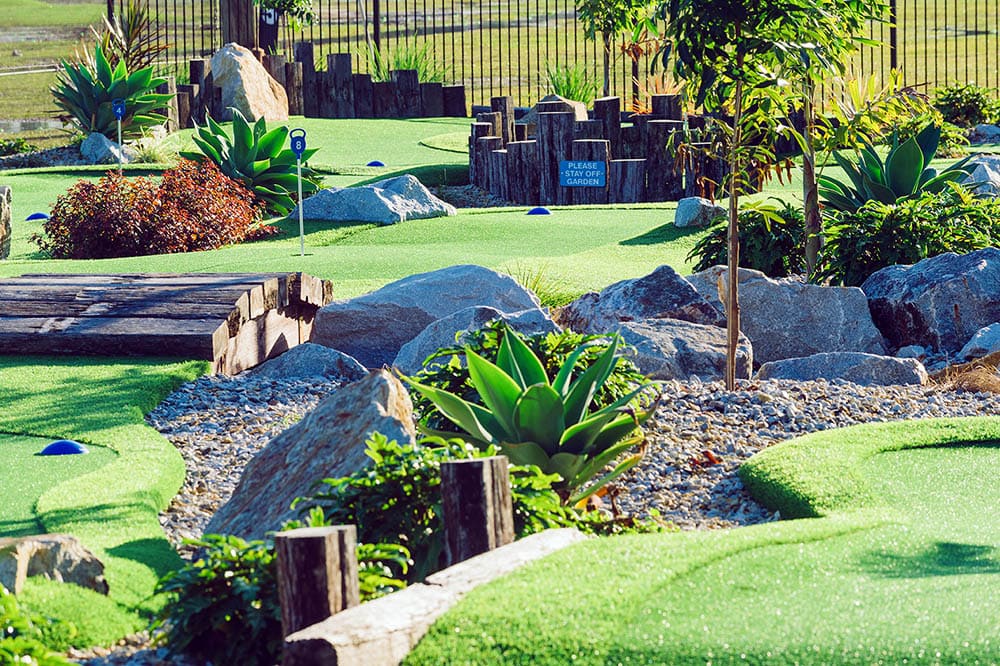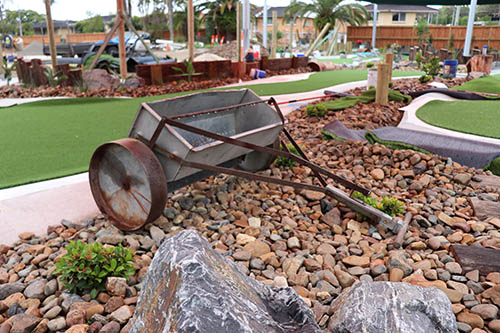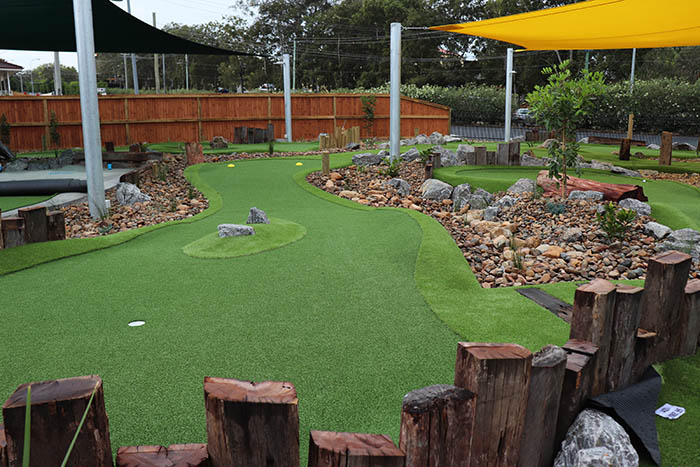Mini Golf
The Things That a Great Mini Golf Course Must Have

Now that you know what not to do with a mini golf course....
It’s time to look at what you should do. After all, the design of the course makes all of the difference when it comes to attracting new players.
Our work on the Virginia Mini Golf Course perfectly highlights all of the things that a great mini golf course should have.
The owner of the course immediately told us that they didn’t want to go down the putt-putt road. While there’s nothing inherently wrong with those courses, they don’t tend to attract more serious golfers. All of the obstacles and gimmicks also require maintenance, which adds cost to the project.
Instead, the owner wanted to create something that was a little more serious. With several golf clubs nearby, he felt that offering something realistic would attract both existing and new players.
This isn’t to say that there are no obstacles at all. There are plenty of rocks, pine posts, and even traditional railway sleepers. Plus, many of the greens we’re designing offer multiple routes to the holes. These routes vary in difficulty, which means the players get to engage in a little risk/reward strategy.
The key here is to find a balance between realistic and fun. That’s what we believe that we’ve achieved here.
That course opened in November 2019, which is just a few months before the writing of this book. We’re sure that it’s going to be a huge success for many reasons, not the least of which is that the course has everything that a great mini golf course needs.
When designing your course, these are the things that you need to include.
Creating a design with good risk v reward creates a challenge without the need to install crazy obstacles
Item #1
Holes of Varying Difficulty
We mentioned how the Virgina course has holes of varying difficulty.
Again, this is all about striking a balance. You want some fairly simple holes to allow people to get into a rhythm. For the casual player, these easier holes represent a chance to get some quick scores on the board. And if they can get a hole in one, they’re having a great time.
For more experienced players, the easier holes act as a warmup for the harder holes to come.
Those harder holes tend to require a little more strategy to overcome. And it’s often these holes that keep people coming back as they try to achieve even better scores.
Item #2
The Risk/Reward Factor
Speaking of strategy, you want your holes to offer a risk/reward factor.
For example, you can create a green that has two routes to the hole. The first is relatively free of obstacles but it’s also a longer route. Typically, the player will need to take several shots to get to the hole, but there’s no risk of them getting stuck at an obstacle.
The second route in this scenario would be much smaller, thus offering the opportunity of a hole in one. However, it would also have several obstacles built into it. If the player mishits the ball, they could end up stuck at one of those obstacles, which means they’ve got to play several shots to free themselves.
But if they get it right, they have the chance to record a great score on the hole and jump ahead of the competition.
Introducing a risk/reward factor adds an extra element of excitement to the game and is challenging golfers to think and make decisions on the fly.
Item #3
Sensible Obstacles
Your mini golf course won’t be devoid of obstacles just because you’re not building windmills and other big features. There are plenty of natural obstacles that you can place onto the course to mix things up a bit.
For example, strategically placed bunkers around the edges of the hole could make players think twice. Even a small power miscalculation could lead to dropped shots. Rocks and boulders could also block seemingly easy routes to the hole.
These more traditional obstacles add that extra element of challenge without appearing gimmicky. Casual players will have fun negotiating them. And your more serious players will appreciate the challenge that they present.

Using natural items like sleeper rails, logs, rocks and even an old item from the shed like above looks great and doesn't cost a bomb
Item #4
A Full Set of 18 Holes
A 9-hole course works well enough if you don’t have a lot of space. However, they tend to limit your earning potential as you can’t charge full price for what is essentially half of the experience.
Ideally, your course will have the full set of 18 holes, or more if budget and space allow. Not only does this allow you to charge more, but it also means you get to keep players on the course for longer. And that means there’s more chance of them buying refreshments as they play, which means even more revenue for you.
Speaking of which…
Item #5
Open Pro Shop/Café
After nine holes of mini golf, the groups playing on your course are going to feel ready for a quick break.
This gives you a chance to create a little extra revenue. If you have a café with food and beverage options, players will stop and get a bite to eat or a quick drink. Offering alcohol is a particularly popular choice, especially when you have parties booked in.
One of our clients is outsourcing the food and beverage to a local cafe. This is working particularly well because both parties can focus on their core skills while increasing revenue. Our client is simply charging a monthly fee for the cafe to operate on site.
Item #6
Proper Drainage
Unfortunately, heavy rains can put paid to a poorly-designed course. That’s why it’s crucial that you have a design that allows for proper drainage.
Drainage is an important consideration because you don’t want water pooling on the course. This is not good for longevity and also means your course will have longer periods of down time.
For example, let’s say that one of your holes has a dip. This is a perfect place for rainwater to collect. And once that water’s there, it’s impossible for people to play that hole. You need to make sure that the water can drain into a runoff point, thus ensuring that wet weather doesn’t shut the course down.
Item #7
Shade Sails
Shade sails reduce the heat of the sun by 5-10 degrees. We have tested this recently and are now recommending shade sails to all of our new clients. The shade sails can come in colour and allow your facility to pop.
Further, the sails can act as a safety net and a place to attach lighting. They are the perfect complement to your course if sun and heat are an issue in the summer months.
Are those pop up umbrellas any good? They can be if you’re working to a tight budget. But they can’t normally be used in stronger winds and they can look tacky. Plus, they do require ongoing maintenance to ensure they are pulled down at the day’s end. With properly installed shade sails they are pretty much set and forget.

Adding shade sails protects from the elements making your course playable even during extreme weather events
On the next page I'll explain how to maximise revenue streams.....
